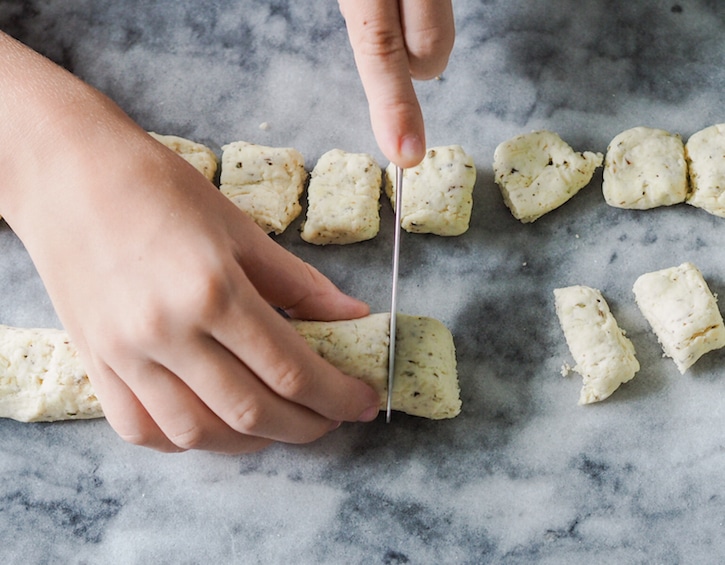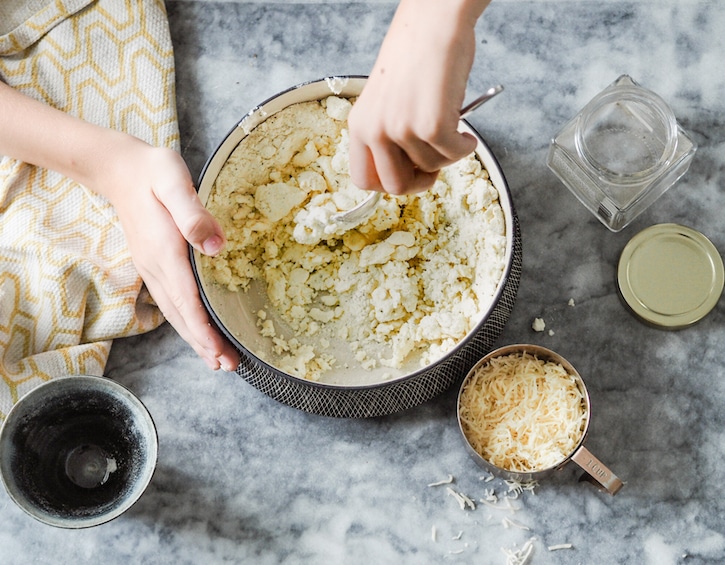
How old should your child be before you let them loose in the kitchen?
Elodie Bellegarde, mama to sons Elliot, aged 7 and Heath, 18 months old, and author of cookbook Kitchen Stories, has always encouraged her eldest to cook from a very young age. Here she shares her tips on getting kids interested in cooking and trying new foods. Elodie’s 7-year-old can now use a proper kitchen knife and the gas hob, and cooks an entire meal for the family by himself. Here Elodie and Elliot tell us their kitchen stories.
I spend a lot of time in my kitchen whether it is for work or for pleasure, so it is only natural to get the boys involved in what I do. I’ve been cooking with Elliot since he was around 2 and am slowly getting Heath involved in the process by smelling and touching ingredients and herbs, or pretending to cook on the kitchen floor. Elliot and I first started by making cakes, Elliot pouring ingredients such as flour, sugar and stirring. I don’t exactly remember when he learnt to crack an egg but it would have been between the age of 2 and 3. It was all very messy but he eventually got the hang of it.

Kitchen knives for kids
We slowly moved on to more “advanced” recipes and skills and at the age of 5, one of my best friends bought him the perfect gift: a knife and peeler set for children designed by Opinel (“Le Petit Chef”). This was a bit of a revelation. The kit includes a “finger guard”, which is a protection to clasp on the first two phalanges, teaching them the correct way to slice without chopping their fingers. With some practice and lots of attention and focus, he can now slice food without the guard and using our large knives, but always under supervision. He knows the correct technique but doesn’t always find it easy to use.
Cooking an entire meal
Since the beginning of the year and pretty much as soon as he turned 7, he has decided to cook us a meal (usually one dish at a time) every week. The deal is that if he cooks, we make the table or have a “picnic” in the living room in front of the TV. He has made us Shakshuka, a couple of salads from Ottolenghi’s Plenty and Jerusalem, vegetarian Pita burger and Gnudi, a ricotta and semolina dumpling.
Preparation and Planning
From experience cooking with Elliot, the secret is to choose simple recipes that won’t take an hour to make. I feel that his attention and interest are elsewhere if we embark on big dishes. And the point is for him to make us something he can be proud of, so we feel it is important he does it himself or with just a little help from us. We look through recipes during the week so I can get the ingredients he needs beforehand. He usually cooks on Saturday or Sunday night, when the atmosphere at home is more relaxed and we have more time to enjoy his food.

Kitchen safety
A recipe that would take me 20 minutes to make might take him twice as long, so giving him time to create his dish without rushing him is important. I don’t leave him alone in the kitchen if he is handling knives or the hob, but I do let him turn on the gas and stir what needs stirring. I think that it is important at his age to give children responsibilities and a sense of ownership. He is the chef, I’m his sous-chef. He makes the mess, I clean up afterwards.
Elliot’s meal
He’s chosen two recipes easy to make at the weekend. The gnudi, inspired by Nigel Slater, needs to be made the day before cooking, which works well if your little chef is impatient. Both recipes require little hands to get messy, which I feel makes the cooking experience fun. And although I do get frustrated with Elliot whenever his mess gets out of control, cooking with children should be a fun experience for both.
Elliott says:
“Gnudi are very easy to make. I like them with broccoli and herbs and olive oil. You have to go through pouring stuff and mixing stuff and when you are at the very end, you have to use your hand muscles and cut it into little balls as if you were going to make a shape with them. You have to mix, squash, roll, cut and press a little.”
Let’s take a look at some of the recipes that Elliott cooks…

Cheese and Herb Gnudi (inspired by Nigel Slater’s Christmas Chronicles).
Serves 3 -4
– 250g durum semolina + extra for dusting
– 250g ricotta
– 1 or 2 tbs dried herbs (we used oregano)
– 1 cup grated cheese (Cheddar, Parmesan, Emmenthal, Comté or Cornish Kern – Elliot is a fan)
Directions
1. Put all the ingredients in a large bowl. Using your hands, mix all the ingredients together until they form a ball. Knead it a little to bring it all together and divide in 4 equally sized balls. Take one ball and roll it into a tube, about 3 cm wide and cut it into little balls. Press each one gently with a finger to flatten it slightly. Proceed with the remaining large balls.
2. Dust a baking tray or a large plate with semolina and place all the gnudi on top. Give the tray a shake back and forth to coat all the dumplings with semolina. Place in the fridge, uncovered, to rest and dry overnight.
3. The next day, bring a pot of water to the boil (I don’t salt mine if Heath is having some). Using a slotted spoon, carefully lower the gnudi in the water. The gnudi are cooked once they float on the surface of the pan. Drain and serve coated with pesto and a side of broccoli.

Buttermilk chocolate scones
Makes 5 to 6
– 150g self raising flour
– 1/4 tsp bicarbonate of soda
– 60g butter
– 1 tbsp brown sugar
– 45 to 50g buttermilk
– 20g dark chocolate (we like 70% minimum), broken into small pieces
– touch of milk, to glaze
Directions
1. Preheat the oven to 180ºC.
2. In a large bowl, mix with your hands the flour, bicarb and butter until the mix resembles sand. Add the brown sugar and repeat. Add the buttermilk and chocolate pieces and bring the mixture into a ball, scraping the side of the bowl to collect all the floury sand. The ball shouldn’t be too wet (add a touch of flour) or too dry (add more buttermilk). Don’t over mix it. Flatten it slightly (about 3 to 4cm thick) and with a small cookie cutter, stamp out rounds. Brush the surface with a touch of milk and bake in the oven for 10-15min until golden and risen.






 View All
View All




 View All
View All










 View All
View All





